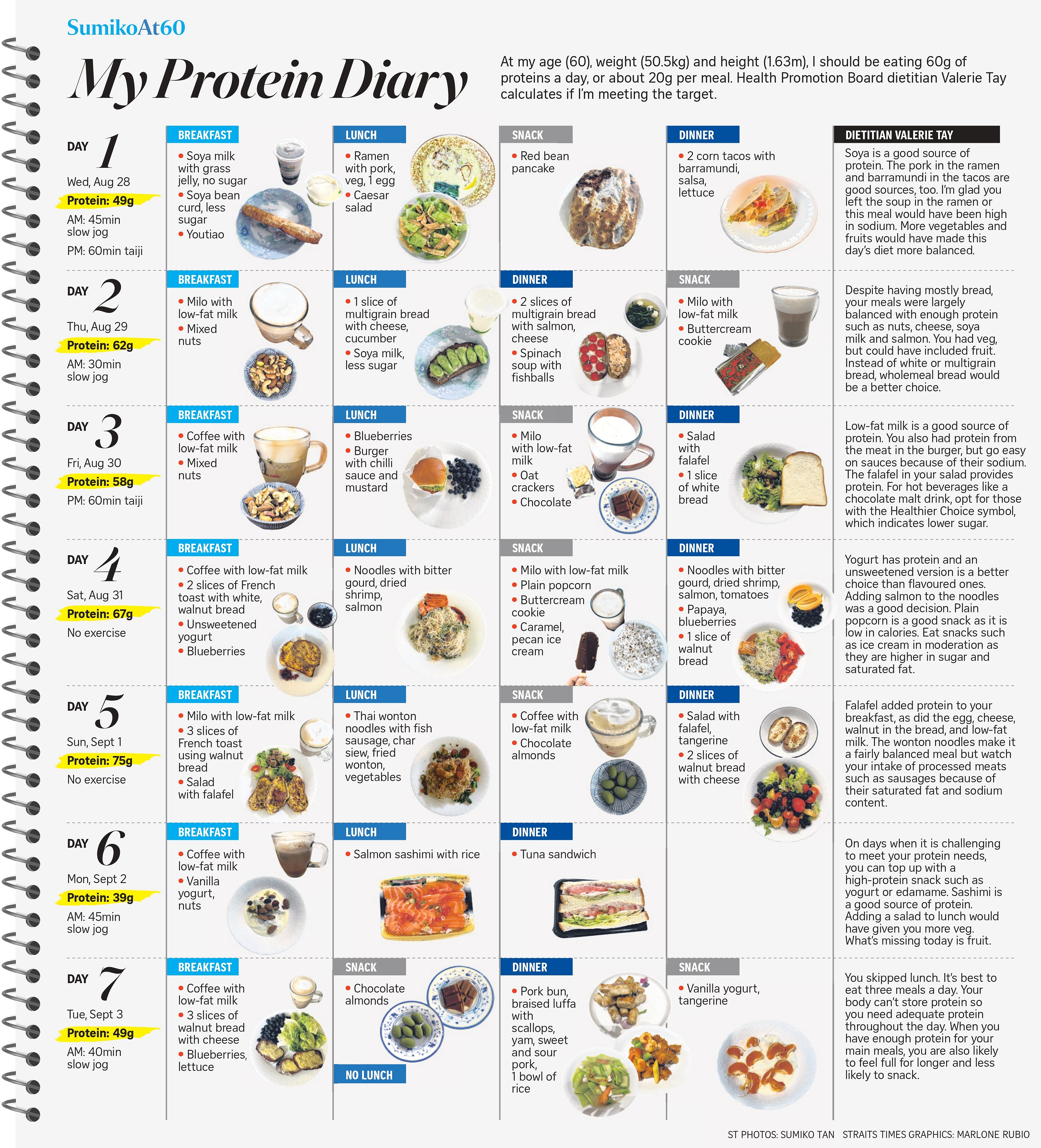Sumiko at 60: It’s best to spread out your intake of protein evenly across three meals
And if you’re over 50, you need 50 per cent more protein, says the Health Promotion Board.


Sitting down with Health Promotion Board (HPB) dietitian Valerie Tay to review 12 days’ worth of meals I had recorded, I felt curious and apprehensive.
Thankfully, she had some positive feedback.
According to the HPB’s “My Healthy Plate” visual guide, a balanced meal should consist of 25 per cent whole grains, 25 per cent proteins, and 50 per cent fruits and vegetables.
She deemed my diet “pretty balanced” on most days. I had included various food groups in my meals, but I should eat more fruit.
I had also met 90 per cent of my protein requirements over those 12 days, Ms Tay calculated. (A seven-day extract of my diet is shown in the graphics.)
But my daily intake of protein fluctuated, with more on weekends. This was not optimal from a nutritional standpoint.
“Protein cannot be stored in the body for later use. Because of this, it’s important to distribute it throughout the day, across all meals,” Ms Tay explained.
This was new to me and highlighted how little I knew about proteins beyond their role in muscle growth.
As a “carbs person”, I love bread, rice and potatoes. I see proteins in terms of chunks of meat, a food group I’d rather avoid if I can help it.
Unfortunately, I can’t.
Adults aged 50 and above should consume about 50 per cent more protein than younger adults to preserve muscle mass, strength and immune functions, among other things, says the HPB.
I’m not alone in not quite meeting my protein needs. The National Nutrition Survey 2022 found that while most Singapore residents met their protein requirements, one in two older adults didn’t.
With that in mind, here are seven things about proteins you might find useful:
1. What are proteins?
Proteins, along with carbohydrates and fats, are “macronutrients” necessary for growth, metabolism and overall functioning.
Proteins are essential to build and repair tissues, make enzymes and hormones, and support immune function. They are crucial for muscle growth and maintenance.
Carbohydrates are the body’s primary source of energy. They are broken down into glucose, which fuels cells, tissues and organs.
Fats are important for energy storage, insulating the body, protecting organs and aiding in the absorption of fat-soluble vitamins.
There are also “micronutrients”, which comprise vitamins and minerals. These are indispensable for immune function, bone health and energy production, though needed in smaller amounts compared with macronutrients.
Of the three macronutrients, is there one that is more important than others, I asked Ms Tay.
“There are people who may think that one macronutrient is better than the other, but the truth is they are all equally important to our body,” she said. “Each has unique functions making them irreplaceable.”
For example, the core function of carbohydrates is to provide the body with energy and not to repair body tissues, which is the main role of protein. On the other hand, fat is used to absorb fat-soluble vitamins. “They really need to work hand-in-hand to keep our body well,” she said.
One should aim for a well-balanced diet to ensure adequate intake of macronutrients and micronutrients.

2. Where can you find proteins?
Protein can be found in a variety of animal- and plant-based food.
Animal-based proteins include meat, fish, seafood, poultry, eggs and dairy products like milk, yogurt and cheese.
Plant-based proteins come from legumes (such as lentils, chickpeas and beans), nuts and seeds, and soya products (for example, tofu and tempeh).
3. What’s the difference between animal and plant proteins?
Proteins are made up of 20 amino acids, of which nine are “essential amino acids” and must come from food as they cannot be made by the body.
Animal proteins are generally considered “complete”, meaning they contain all nine essential amino acids in the correct proportion. The only exception is gelatin.
Animal proteins are easily digestible and hence absorbed and used by the body, with less waste for excretion after metabolism, said Ms Tay.
On the downside, some are higher in saturated fats or sodium and can lead to health problems when consumed in excess. This includes fatty cuts of red meat, processed meats such as bacon and sausages, and full-fat dairy products.
Except for soya foods such as tofu, soya milk and tempeh, plant proteins are often classified as “incomplete” proteins, lacking in one or more essential amino acids.
These incomplete proteins are generally less digestible or less utilised by the body and produce more waste, though cooking can enhance their digestibility.
Ms Tay recommends “complementary pairings” to make plant-based proteins “complete”. This includes pairing grains, which contain some essential amino acids, with nuts or beans. Think porridge cooked with red beans, or peanut butter on wholemeal bread.
“This combination compensates for any essential amino acids lacking in one plant-based protein source by drawing them from the other,” she said.
If such pairings within the same meal are not possible, you can do it across the day’s meals.
She also suggests alternating between animal- and plant-based proteins to keep cholesterol and saturated fat intake in check.
In opting for animal proteins, go for lean cuts of red meat and remove visible fat and skin of poultry to reduce saturated fat intake, she added.
4. How much protein do you need?
The recommended protein intake for adults aged 18 to 49 is 0.8g of protein per kilogram of body weight per day. This means a person weighing 65kg should consume about 52g of protein daily (0.8g protein x 65kg body weight).
Adults aged 50 and above need more protein. The recommendation increases to 1.2g per kg body weight, so a 65kg person would need about 78g daily. This increase helps to slow down the progression of sarcopenia, or age-related muscle loss, said Ms Tay.
Sarcopenia can occur from as early as the age of 40 due to reasons such as reduced physical activity and inadequate protein intake, compounded by the ageing body’s reduced efficiency at using protein to build and maintain muscles.
Associate Professor Yusuf Ali, who specialises in metabolic disease at the Lee Kong Chian School of Medicine at the Nanyang Technological University, said increased protein intake must be accompanied with physical activity, especially weight-bearing exercises. Otherwise, muscle protein turnover, which regulates tissue mass and function, will be affected.
5. Why should you spread your protein intake throughout the day?
Muscle proteins undergo constant breakdown and growth throughout the day, and this requires regular protein intake for support, said Ms Tay.
In a process known as muscle protein synthesis (MPS), the body repairs damaged muscle tissues and builds new muscle proteins. Adequate protein intake stimulates MPS, which can help compensate muscle protein breakdown to maintain balance.
“Distributing protein intake throughout the day ensures your muscles have the necessary nutrients for recovery and growth at any one time.”
While you can consume a large of amount of protein in a single meal, there is a limit to how much protein can be actively used at any given time, she added. Thus, it is recommended that protein intake be spread across the day.
For a 65kg older adult with a daily protein recommendation of 78g per day, this works out to be about 25g of protein at each meal. “This is also the approximate amount of protein we can effectively use at one time,” Ms Tay added.
If a meal lacks protein, make up for it with a protein-rich snack such as a handful of nuts, she suggested.
Prof Yusuf pointed out that proteins are not only the building blocks of cells, they also assist with respiration and maintaining the basic properties of blood and are a source of neurotransmitters.
The body adjusts to decreases in dietary protein intake by interchanging energy sources, but only to a certain threshold, he said.
Beyond this, hypoproteinemia – an abnormally low level of protein in the blood – ensues, leading to symptoms such as fatigue and malaise, migraine, nail brittleness and stress (bone) fractures.
As for whether one can overeat protein, Ms Tay said there is generally little harm for most healthy individuals.
But consistently high protein intake that exceeds caloric needs can cause weight gain. In exceptional cases, for people predisposed to or who have existing kidney diseases, excessive intake can contribute to additional workload on the kidneys, she said.
6. What is a meal-sized serving of protein like?
As a guide, 20g to 25g of protein looks like this:
- A palm-sized piece of lean meat, chicken or fish
- 5-6 medium-sized prawns
- 3 eggs
- 500ml of low-fat milk or lower-sugar soya milk
- 4 pieces of tempeh
- 2 small blocks of tofu
Ms Tay pointed out that you don’t need to see proteins as chunks of meat or big squares of tofu. Little bits of protein – and other nutrients, for that matter – in different dishes all add up.
Referring to a chicken burrito I ate which I hadn’t thought was particularly nutritious, she said it had bits of grilled chicken and chick peas (proteins), some vegetables and I had chosen a wholegrain wrap.
“It’s almost a balanced meal,” she said, and even better was how I had added blueberries. The next step would be to aim for the recommended servings from each food group to meet my nutritional needs.
7. Proteins can reduce the desire to snack
Another advantage of eating enough protein at every meal is that it can help reduce the need to snack.
Protein takes a longer time to digest due to a more complex molecular structure, and can make you feel full for longer compared with eating only carbohydrates, Ms Tay said.
Prof Yusuf noted that the feeling of hunger is primarily driven by ghrelin, a hormone released by the stomach when it is empty, signalling the brain to tell you that you are hungry. Protein-rich meals reduce the secretion of ghrelin.
Delving into the world of proteins opened my eyes to why I should be paying more attention to this nutrient.
I also learnt that consuming protein is not as onerous as I’d thought. Ten almonds provide about 3g of protein and a glass of soya milk about 10g. These are already in my diet.
I will just have to be more conscious about eating enough protein, and across all my meals – even though I’d really prefer to be loading up on carbs.
Join ST's Telegram channel and get the latest breaking news delivered to you.


No comments:
Post a Comment